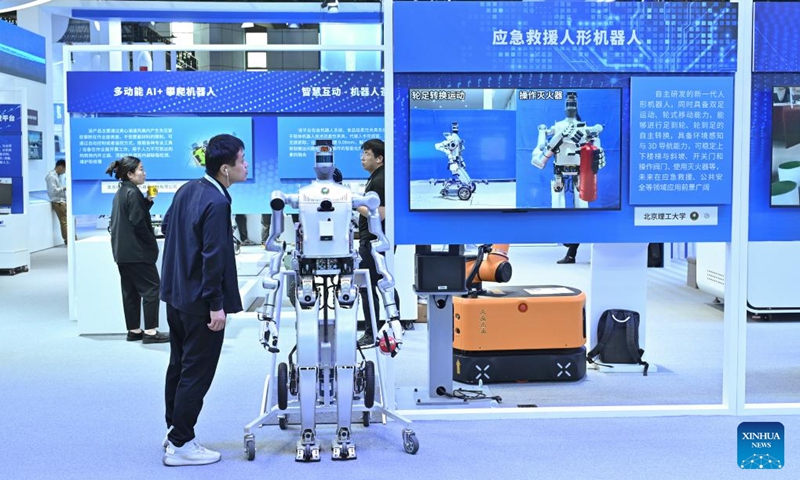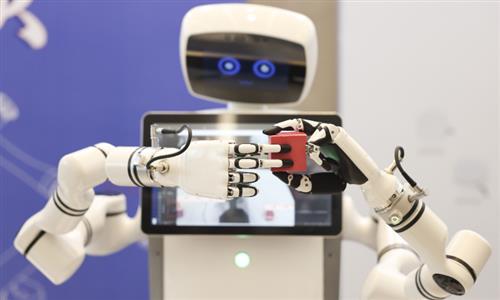More humanoid robots now work on auto assembly lines in China, enhancing efficiency

This photo taken on April 26, 2024 shows an emergency rescue humanoid robot during a permanent exhibition at the Zhongguancun Exhibition Center in Beijing, capital of China. The permanent exhibition will be opened to the public recently, showcasing more than 430 technologies and products from more than 320 research institutions and enterprises in Beijing in cutting-edge fields such as artificial intelligence, quantum information, commercial aerospace, life and health, and synthetic biological manufacturing.(Photo: Xinhua)
A Chinese humanoid robot company announced it will deploy humanoid robots in an automobile factory, the company told the Global Times on Tuesday, marking a further maturation of China's humanoid robot technology in aiding the manufacturing sector.
UBTech's industrial humanoid robot, Walker S, will be deployed at Dongfeng Liuzhou Motor to conduct a series of tasks such as inspecting seat belts, door locks, and headlight covers, as well as performing oil filling, front axle subassembly and material picking. The deployment aims to free humans from repetitive work.
They will also work alongside traditional automation equipment for flexible unmanned production in complex scenarios as well as more difficult tasks like inspection and logistics.
“In addition to the automobile manufacturing field, our humanoid robots aim to be applied in 3C (computer, communication and consumer electronics) factories. We do not have a preset direction to develop new technology, but to improve the product based on user needs and feedback, the future application scenarios can be very diverse,” a representative from UBTech told the Global Times on Tuesday.
“We plan to begin small-scale manufacturing of the robots at the end of this year, with the aim of achieving mass production by 2025 or 2026,” said the representative.
“Humanoid robots mainly engage in repetitive, high-risk and difficult technical work to improve efficiency and protect human safety. Besides, due to the human-like characteristic, they can deal with some service work such as hospital nurses, restaurant waiters to meet the emotional needs of patients or customers,” Ma said.
“The integration of humanoid robots with the industrial and manufacturing sectors will become the largest application scenario in China,” Liu Gang, director of the Chinese Institute of New Generation Artificial Intelligence Development Strategies, told the Global Times in an earlier interview.
Currently, the cost of the industrial version of the humanoid robot is $40,000 to $50,000, while an experienced worker in the assembly line of a vehicle factory earns 180,000 ($25,200) to 200,000 yuan a year. If the cost is further reduced, it is expected that the robots will be used to replace more workers, the People’s Daily reported.
In 2023, China's humanoid robot industry boomed, growing to 3.91 billion yuan in scale, up 85.7 percent year-on-year. The sector is expected to continue its rapid growth in 2024 and 2025, with the market size projected to exceed 20 billion yuan by 2026, according to data released by China Center For Information Industry Development.
Over the past 10 years, China has leaped in the humanoid robot technology field. The number of humanoid robot patent applications and the number of valid patents now ranks first globally, according to another report by the People's Daily.
However, the development of humanoid robots would encounter challenges. “The advanced development and training cost and the absence of comprehensive ethical rules and regulations, making it difficult to replace labor on a large scale,” Ma said. “Now we are only conducting small-scale pilot projects, and it will take about 5-10 years before achieving large-scale multi-scenario applications.”
According to a Goldman Sachs forecast, the global sales of humanoid robots from 2025 to 2035 will reach compound annual growth rate of 94 percent, and the market size in 2035 will expand to reach $154 billion.
“The development of humanoid robot industry will drive the mechanical, electronic, sensing, software, and other high-end industries to develop together. As a segment of the new quality productive forces, the development of China's humanoid robots will have a bright future,” Liu said.

